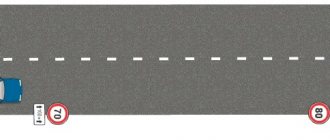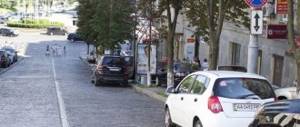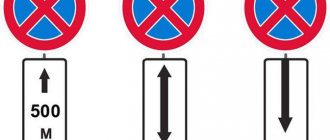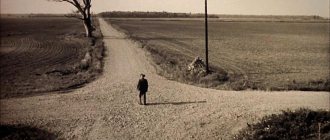Bus stop sign concept
As required by the rules, the presentation of the sign must be two-sided. Its image provides information to passing and oncoming traffic about special sections of the road, about various city transport stops, as well as for them to take safety measures:
- reduction in speed,
- don't overtake
- pay attention on pedestrian areas,
- maneuvering according to traffic rules.
A bus stop sign, like any other sign, notifies the driver of the necessary actions on a certain section of the road.
8.2.1 "Area"
Administrator May 27:
Among additional information signs (or signs), a special place is given to a group of signs called “Area of Operation”.
The traffic rules provide for the use of these signs if there is a need to limit the coverage area of certain signs, as well as to indicate the length of dangerous sections of the road.
There are six “Area of Action” signs in total.
Let's consider the first of them - 8.2.1.
First of all, the “Area of Action” sign is used with five prohibitory signs: 1) “Minimum distance limitation” (3.16); 2) “Overtaking is prohibited” (3.20); 3) “Overtaking of trucks is prohibited” (3.22); 4) “Maximum speed limit” (3.24); 5) “Sound signal is prohibited” (3.26).
If you remember (and this must be remembered!), these prohibitory signs are valid from the place of their installation to the place where the prohibitory sign “End of the zone of all restrictions” is installed, the nearest intersection, and when driving in a populated area - to the end of the populated area. (There are other ways to terminate them, but the options noted are common to all of them.)
Now imagine that it is inappropriate to extend the coverage area of any of these signs to the specified sections of the road - the “End of zone of all restrictions” sign, an intersection or the end of a populated area. There's simply no need for it.
And in these conditions, the “Area of Action” sign will be a way out of the situation. It will indicate the extent of the coverage area of the prohibitory signs installed with it.
The "Area of Action" sign is often used with a variety of warning signs. Such a combination should be considered as an indication of the length of the dangerous section of the road, expressed by a warning sign.
However, it should be noted here that many drivers make an unfortunate mistake in understanding this combination of signs. Let's take as a basis the example of a traffic situation shown in the figure.
Uninformed drivers believe that a dangerous section of the road associated with dangerous turns will begin from the place where the signs are installed and will continue for 500 meters. This is a fundamentally incorrect interpretation. The correct option is different: after 150-300 meters from the place where the signs were installed, a dangerous section of the road will begin, associated with dangerous turns, which will continue for 500 meters.
Agree, this difference is fundamental. You just shouldn’t forget about the rules for installing warning signs (50-100 meters in a populated area and 150-300 meters outside a populated area before the start of a dangerous section of the road). The sign will only indicate the extent of the dangerous area, but will not cancel the principles of installing warning signs. Remember this please!
The rules also provide for the use of a “Area” sign with two information signs - “Recommended speed” (6.2) and “Parking (parking space)” (6.4). If you remember, their coverage areas are limited to the nearest intersection along the route. Therefore, the “Validity Area” sign is used in conjunction with these signs when there is no need to extend the effect of the signs to the intersection.
Thus, the “Validity Area” sign is used, firstly, to limit the coverage area of the signs installed with it, and secondly, to indicate the length of dangerous sections of the road indicated by warning signs.
Traffic regulations online from the autoass team!
- sign 8 2 1
- coverage area sign
- road sign 8 2 1
- sign coverage area
What does the sign look like according to GOST?
This is what a bus stop sign looks like according to GOST requirements. It is installed at the beginning of the stop; if there is a pavilion on the site, you can install it on the edge so that the sign is visible to approaching vehicles.
In the city, the sign must be double-sided; single-sided ones are used outside the city on roads where there are areas with a dividing strip, in the absence of pedestrian traffic along the road.
If it is necessary to indicate the length of the stop area, which is not very pronounced, or to indicate the next stopping points located, it is permitted to use a bus stop sign with table 7.2.1., which indicates it or the total length of the remaining areas.
Additional inscriptions are placed on the sign in its lower part. This sign is installed at the beginning of the stop.
“Two pieces of iron, two waters”: top 10 simple traffic rules memos
When driving school students first learn the Rules of the Road, it seems to them that it is impossible to remember all these nuances. But in this matter, attentiveness, patience and, oddly enough, ingenuity are important. Everyone has long known that poems, tables, drawings, jokes are remembered much easier than long and boring formulations. To make training easier for current and future cadets, the TAM.BY team together with the AvtoDelo Plus driving school have collected simple traffic rules memos.
Rule #1. Traffic controller signals
Surely both drivers and pedestrians have seen how traffic controllers show not only the signals prescribed by the rules, but also personally escort almost every car to the required turn. And all because motorists do not always remember what the signs given by the traffic controller mean. We'll fix it!
The traffic controller signals have the following meanings:
36.1. arms extended to the sides or lowered:
36.1.1. from the left and right sides it is allowed: for the tram to move straight, for other vehicles to move straight and to the right, for pedestrians to cross the roadway;
36.1.2. from the chest and back: the movement of all vehicles and pedestrians is prohibited;
36.2. right arm extended forward:
36.2.1. from the left side it is allowed: for the tram to move to the left, for other vehicles to move in all directions;
36.2.2. from the chest: all vehicles are allowed to move only to the right;
36.2.3. from the right side and back: the movement of all vehicles is prohibited, pedestrians are allowed to cross the road behind the back of the traffic controller;
36.3. hand raised: movement of all vehicles and pedestrians is prohibited in all directions.
To remember the signs of a traffic controller, there is a simple poem that is familiar to many.
The stick is pointed upward - it tells everyone to stand. If the stick points to your mouth, make a right turn. If the stick points to the right, you have no right to ride. If the stick points to the left, you can go wherever you want. The “bare” chest and back are a wall for the driver.
Rule #2. Remaining tread height
With the help of this memory, you can once and for all learn the minimum residual value of the tread pattern. If it is lower, then the vehicle is not allowed to participate in road traffic.
Passenger car tires have a residual tread depth of less than 1.6 mm, truck tires - 1 mm, buses - 2 mm, motorcycles and mopeds - 0.8 mm.
To remember, we will use a small table and the abbreviation MGLA - Motorcycle (Moped), Truck, Car, Bus.
Types of bus stops
These are special designated areas for the safe embarkation and disembarkation of passengers of ground transport buses, trolleybuses, trams, and minibuses. Indicated by a sign that corresponds to a specific stop.
They are always equipped with a sign indicating:
- route numbers stopping at this location,
- public transport schedule,
- route maps.
The bus stop must be equipped with special equipment in accordance with GOST:
- road signs,
- markings,
- traffic lights and fences.
There are two types of bus stops or car pavilions: open ones are canopies, closed ones are a structure blocked on three sides; for the convenience of passengers, benches are installed so that they can wait out bad weather, snow, and rain in a shelter.
Outdoor advertising or ticket sales points may also be placed, but concession kiosks are prohibited. Within the designation of a public transport stop, there is a road mark - a taboo for parking cars.
There are two types of main stops:
- permanent stop - the stay of transport according to an approved schedule, after a certain period of time,
- upon request - identification signs are not always present at such a stop site. A waiting passenger, by raising his hand or pressing a button, if any, can stop the approaching vehicle, otherwise the bus or minibus will pass by.
State supervision [ edit | edit code]
Based on paragraph 11 of Article 2 of the Federal Law of November 8, 2007 N 259-FZ “Charter of Road Transport and Urban Ground Electric Transport” - a stopping point is a stopping place for vehicles along the route of regular transportation, equipped for boarding, disembarking passengers and waiting for vehicles. [2]
Based on paragraph 5 of Article 3 of the Federal Law of November 8, 2007 N 257-FZ “On highways and road activities in the Russian Federation”, a stopping point is an element of the development of highways. [3]
In accordance with paragraph 6 of Article 19 of the Federal Law of November 8, 2007 N 259-FZ “Charter of Automobile Transport and Urban Ground Electric Transport”, information about the type of regular transportation of passengers and luggage, schedule, the start and end time of the movement of vehicles along the corresponding route, the name of the final stopping point of the route, information about the name, address and contact telephone numbers of the body exercising control over the regular transportation of passengers and baggage. The content of information included in the schedule is determined by the rules of passenger transportation. [4]
Based on paragraph 7 of Article 16 of the Federal Law of October 6, 2003 N 131-FZ “On the General Principles of the Organization of Local Self-Government in the Russian Federation” and the decision of the Central District Court of Khabarovsk on the claim of the prosecutor’s office dated September 11, 2012, the municipality (the executive body of local self-government) is entrusted duty and responsibility for creating conditions for the provision of transport services to the population and organizing transport services for the population within the boundaries of the urban district. [5] [6]
In accordance with Article 13.1 of the Federal Law of 08.11.2007 No. 257 “On Highways”, paragraph 6 of Article 3.1 of the Federal Law of 08.11.2007 N 259-FZ “Charter of Automobile Transport and Urban Ground Electric Transport” and the Decree of the Government of the Russian Federation of 09.06. 2010 N 409 “On the implementation of control (supervisory) functions by officials of the Federal Service for Supervision in the Sphere of Transport.” State supervision over the condition of stopping points is entrusted to the territorial departments of the road inspection Rostransnadzor. [7] [8] [9] [10]
Based on paragraph 6 of Article 30 of the Federal Law of December 10, 1995 N 196-FZ “On Road Safety”, an on-site unscheduled inspection is carried out at the request of citizens and organizations immediately, with notification to the prosecutor’s office. [11] [12]
Road signs regulating public transport stops are signs of special regulations and are contained in Section 5 of the Traffic Rules. Violation of their requirements may entail administrative liability provided for by the Code of Administrative Offenses of the Russian Federation. Below we will talk about what public transport stop signs are, what their coverage area is and what fines are provided for violating them.
How to stop at a bus stop?
A car is a complex piece of equipment, and some problems may arise unexpectedly. At such a moment, the driver cannot objectively assess the situation and quickly, without a preliminary inspection, identify a breakdown of any part of the car; these can be faults of different tones:
- steering and brake systems,
- damage to dimensions and headlights,
- malfunction of windshield wipers in bad weather.
If in this case you had to use parking at a stop, then this is not considered a violation and does not threaten the “violator” with a monetary penalty.
Don't forget to put out the emergency stop sign. Dangerous malfunctions detected in the operation of the vehicle prohibit further use. First of all, public needs are taken into account; there must be compelling reasons for stopping at the bus site.
If you had to stop, then you need to do it without interfering with the main transport to freely disembark and pick up passengers.
Parking to the bus stop sign
Parking means parking a vehicle on the edge of the road or in a designated area for a long period of time.
But parking cannot be done 15 meters before and after a public transport stop, but it is possible if personal transport does not interfere with public transport. The calculation is made based on the sign indicating the stop, regardless of which side the car is on.
Who is allowed to stop for more than 5 minutes?
At a bus stop, a motorist can disembark and pick up people from his vehicle.
It is also possible to load and unload cargo into a vehicle, provided that the vehicle is parked for no more than 5 minutes, without interfering with passengers or the movement of shuttle buses. An emergency stop of a car is allowed on a bus in the event of a breakdown and the ability to quickly fix it.
How many meters before should you stop?
The car must stop 5 meters before the pedestrian crossing, after it the distance does not matter, the main thing is not to stop at the zebra crossing.
For two-way traffic, the action is the same.
Is it possible to avoid punishment?
There are small relaxations that come into force if the car suddenly suffered a sudden breakdown and was forced to stop right on the roadway at a bus stop. None of the drivers can predict this situation, because the car’s mechanisms can fail for anyone, regardless of experience or the technical condition of the car. Such a situation on the road will be regarded as an involuntary and necessary stop, for which the driver will not be subject to a fine. The causal list could be as follows:
- if there are faults in the steering system or brake mechanism;
- in case of breakdown of the electrical system and malfunctions of side lights or headlights;
- sudden failure of the windshield wipers if weather conditions do not allow driving without them.
The driver can stop his car in case of these breakdowns and failure of mechanisms, and the inspector does not have the right to fine him or transport him to the impound lot. In this case, the malfunction is eliminated on the spot with the obligatory setting of alarm signals. If it is impossible to repair the breakdown, the car owner calls a tow truck or someone they know and delivers the car to a service center.
Traffic rules when boarding and disembarking passengers at a stop
The rules state that boarding and disembarking passengers at a public stop is permitted and is carried out after a complete stop of transport from the side of the road or sidewalk, provided that it does not interfere with other vehicles.
And it is not recommended in places where it is prohibited to do this; in this regard, there is an article subject to a fine from a small amount to an impressive amount.
Here are some prohibited places:
- where the prohibition sign hangs,
- when tram travel is restricted on its tracks,
- railway track,
- in the tunnel,
- no more than 15 meters before and after a pedestrian crossing, intersection,
- in narrow areas,
- in the bike lane.
It is necessary to know and adhere to traffic rules.
Reader Questions
Can my car be towed if I constantly leave it in an area where a sign prohibits stopping?
Answer: This situation is possible, but if there is an additional sign with a picture of a tow truck under the sign prohibiting stopping vehicles. As an option, a sign is used that says “A tow truck is working.” If this violation is noticed by the traffic police, they will issue a fine of 1,500 to 3,000 rubles. (if we are talking about the capital or St. Petersburg).
What kind of stop should be considered forced?
Answer: The concept of a forced stop is prescribed in paragraph 1.2 of the Rules.
Fines for violation
If for some reason the driver had to stop at the site designated as a stop, then the possible actions of the traffic police officer who detected the violation:
- issuing a fine, the amount may fluctuate,
- or to evacuate the vehicle that violated the rules.
The driver's obligation will include payment for transportation and security in the parking lot of the seized vehicle. The best option would be for the car owner to independently eliminate the obstacles created by his vehicle.
Also, a fine may be imposed for reasons of incorrect parking:
- which creates interference,
- parking in front of a pedestrian crossing,
- in places reserved for disabled people,
- when parking second row,
- on playgrounds,
- on the lawn,
- sidewalk.
In order not to find yourself violating the rules and not having to pay fines, tow truck services and impound parking, you should try to park at bus stops for a few minutes and for good reasons, without creating any difficulties for the movement of public transport.
When disembarking or picking up passengers, it is better to park before or after the bus stop within fifteen meters.
Conversation with the inspector in case of violation
The reason for the absence of a road sign may be several factors:
- Having opened a new stop, the installation of the sign was postponed for a while,
- The previously installed sign was damaged, it was removed, and a new one was not installed.
But no matter how the reason influences the absence of a sign, the driver who violated the rules, with a sense of tact, in an unobtrusive form, can try to assure the traffic police inspector of his innocence. And then the likelihood of avoiding a fine will increase.
WATER SUPPLY FACILITIES
235 Ground water pipes [48, 54, 144] 236 Underground water pipes [48, 54, 144] 237 Streams and gutters for water supply [54, 145]:1) ground
2) on supports 238 Kyarizy [144]: 1) active 2) inactive 239 Main wells in steppe and desert areas (numerator - mark of the ground surface at the well, denominator - depth of the well in m to the water level and to the bottom) [144, 146 ] 240 Wells (IX-VI months when the well has water) [146] 241*
I. Wells with mechanical lifting of water [146, 147] 2. Concrete wells with mechanical lifting of water [146, 147] 242 Wells with a wind engine [148] 243 Wells located inside buildings; wells combined with water towers and pumping stations [148]Table No. 31
| No. conditional signs | NAMES OF CONVENTIONAL SIGNS | IMAGE |
| 244 | 1. Artesian wells and artesian wells [148] 2. Artesian wells with pumping devices [147, 148] | |
| 3. Artesian wells located inside buildings [148] | ||
| 4. Artesian wells located inside buildings, combined with pumping devices [147, 148] | ||
| 245 | Water taps (outside populated areas) | |
| 246 | Chigiri | |
| 247 | Stationary pumps (without buildings) on canals (1) and mobile pumps on canals (2) [149] | |
| A | ||
| 248 | Open, covered and underground reservoirs, settling tanks, pools, rain pits (2 and 3 are the height of the embankment in m; 1II-V1 are the months when the reservoir has water) [124, 150] g | |
| 249 | Sources (keys, springs)[151]: 1) unequipped | |
| 2) equipped | ||
| 250 | Fountains | |
| 251 | Geysers |
Table No. 32
| No. conditional signs | NAMES OF CONVENTIONAL SIGNS | IMAGE |










